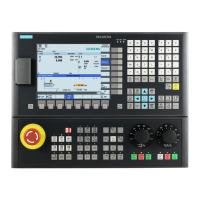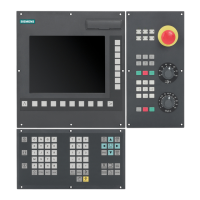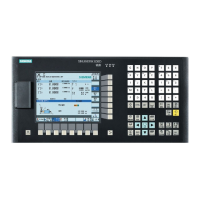K3: Compensations
4.4 Interpolatory compensation
Extended Functions
252 Function Manual, 03/2013, 6FC5397-1BP40-3BA1
Application for table multiplication
The following example for the compensation of machine foundation sagging illustrates an
application of table multiplication.
%RULQJPLOO
=PHDVXUHGYDOXH
)RXQGDWLRQXQGHUORDG
=
;
;PHDVXUHG
YDOXH
ෙ;
˟
Figure 4-7 Compensation of sag in a foundation
On large machines, sagging of the foundation can cause inclination of the whole machine.
For the boring mill shown above as an example, the compensation of the X1 axis depends
on the position of the X1 axis itself, since this determines the angle of inclination β, and on
the height Z1 of the drill.
The compensation values of the X1 and Z1 axes should be linked as follows for a
compensation:
ΔX1 = Z1 * sinβ(X1) ≈ Z1 * β(X1)
;
VHWS6&RPS
;
VHWS
=
VHWS
7DEOH
7DEOH
VLQ˟;
;
=
ː
Figure 4-8 Table multiplication
Compensation table 1 (index = 0) describes the reaction of axis X1 on axis X1 (sine of the
position-dependent tilting angle β(X1)).
Compensation table 2 (index = 1) describes the reaction of axis Z1 on axis X1 (linear).
In table 1, the multiplication of table 1 (index = 0) with table 2 is to be selected:
$AN_CEC_MULT_BY_TABLE[0] = 2

